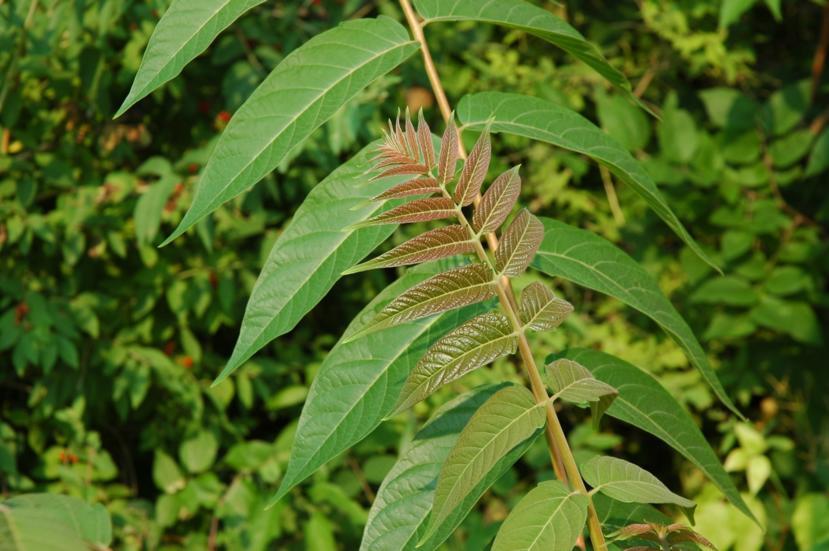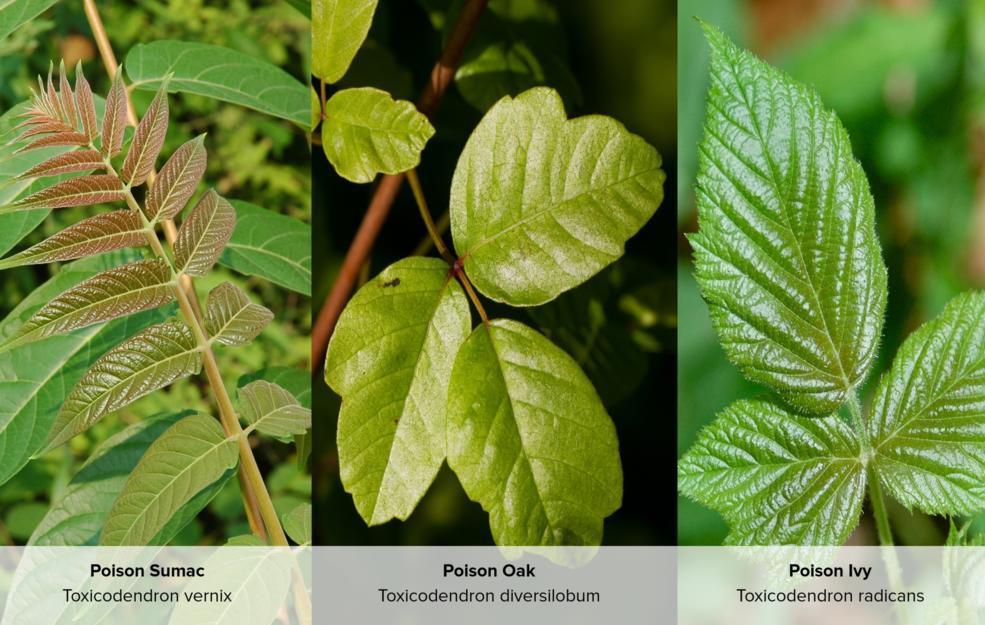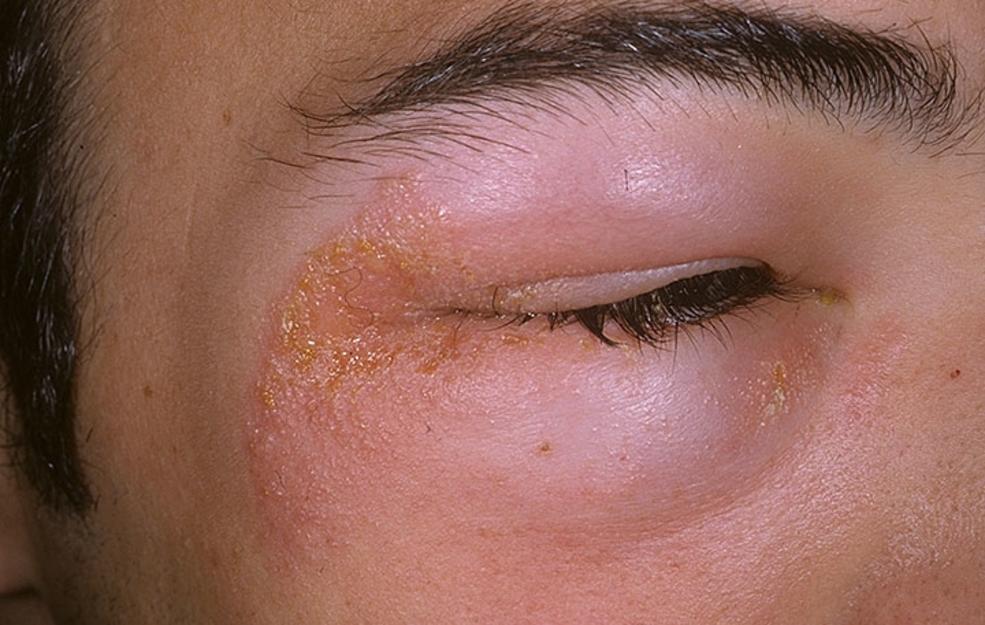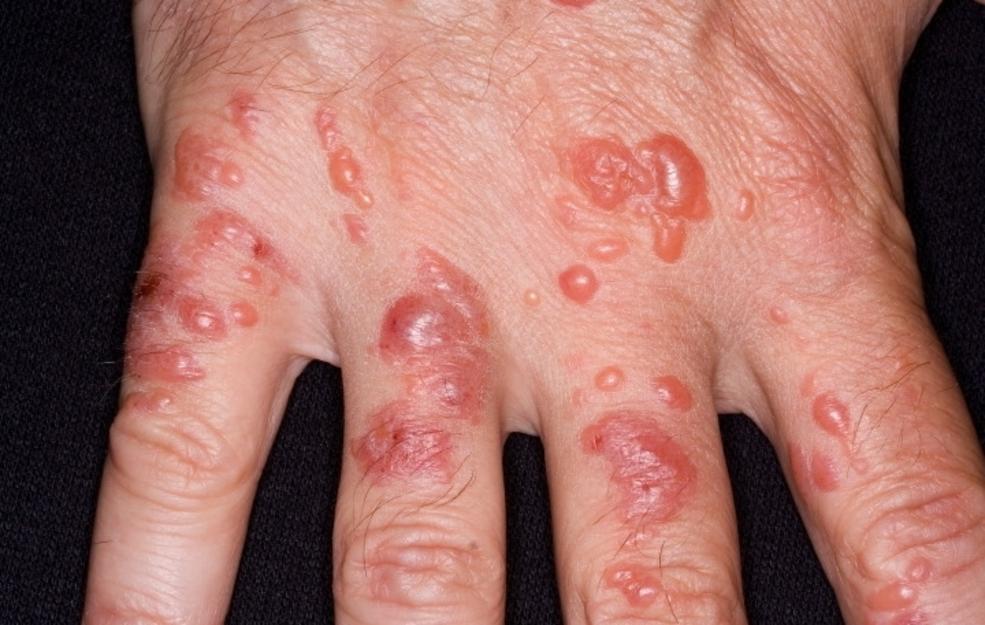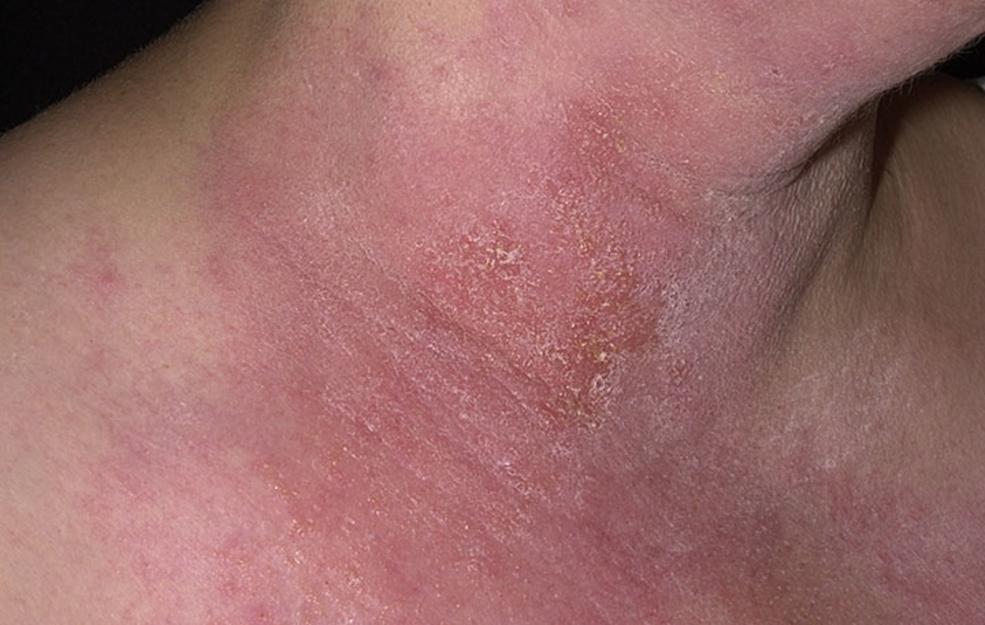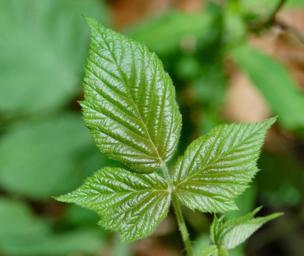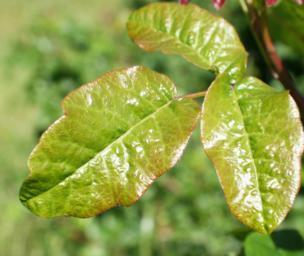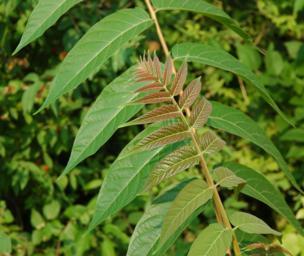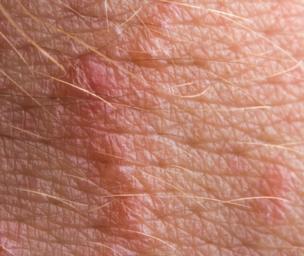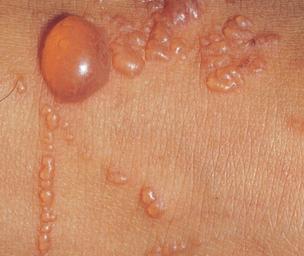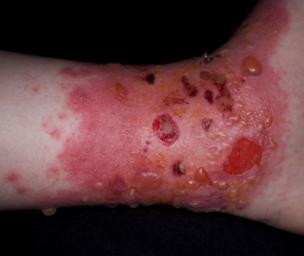Poison sumac, or Toxicodendron vernix, is a woody shrub that is commonly mistaken as a tree, especially once it has fully grown. It contains an oil called urushiol, which is toxic to humans. Skin contact with this oil causes an allergic reaction. This is a resinous and toxic oil produced by the poison sumac plant. It appears yellow in color until it seeps out of the plant and reacts with oxygen. At that point, the fluid turns black. It covers the entirety of the plant, including stems, leaves, flowers, berries, and even its roots. In fact, urushiol oil remains potent for up to five years, even after the plant has died. Urushiol oil is the same oil found in poison ivy and poison oak.
Poison Sumac Rash
1 What is poison sumac?
2 What is a poison sumac rash?
Poison sumac rash, or allergic contact dermatitis, is contracted when your skin comes in contact with urushiol oil. This is a resinous and toxic oil produced by the poison sumac plant. It appears yellow in color until it seeps out of the plant and reacts with oxygen. At that point, the fluid turns black.
When urushiol comes in contact with the skin, it takes 10 to 20 minutes before it binds with the skin. This makes it very difficult to remove or wash off. The rash is the body’s natural reaction to fight off the toxins found in urushiol oil.
Poison sumac rashes are characterized by severely itchy, angry red rashes. Its symptoms include itching, the skin turning red or producing red streaks, hives, and fluid-oozing blisters. What is unique about poison sumac rashes is that it takes a while before the onset of symptoms. The incubation time can be as long as a week between contact with urushiol oil and the appearance of the first symptoms.
Most cases of poison sumac rashes are mild enough and can be treated with home remedies. However, for some people, visiting a doctor or heading to the emergency room may be necessary. Severe poison sumac rashes can cause a person to have difficulty breathing. This is particularly dangerous as a person may have a serious allergy to the oil. It may also cause large blisters, oozing fluids, and spread throughout the body. Lastly, it could cause swelling on the face, mouth, neck, and genitals. With severe swelling, the eyelids can even be swollen shut.
In some cases, contact is not necessary to contract the poison sumac rash. People may unwittingly burn the plant, hoping to destroy it. However, urushiol oil, the toxic substance in the plant, can attach itself to the smoke, making it airborne and affecting more people. Exposure to the smoke can then cause skin rashes, and worse yet, breathing it in can cause serious harm to your lungs. This can also happen during an event such as a forest fire.
3 What are the symptoms of a poison sumac rash?
Poison sumac rashes have a number of symptoms, which are largely similar to other contact dermatitis cases. This makes it difficult to diagnose on your own. But watch out for these symptoms:
- Severe itching
- General redness of the affected area of skin
- Appearance of red streaks on the skin
- Hives, which could be small bumps or large raised areas
- Blisters that ooze fluid
These symptoms are not extremely dangerous. However, they can be severely uncomfortable, inconvenient, and painful. Some people can be more sensitive to urushiol oil, and this can cause more severe allergic reactions.
Here are some symptoms of severe allergic contact dermatitis:
- Difficulty breathing
- Severe and large blisters that could be widespread throughout the skin and generously ooze fluid
- Swelling of the face, mouth, neck, and even the genitals; this could even cause the eyelids to shut.
In cases of severe poison sumac rashes, it is very important that you visit a doctor immediately so that he or she may give you the correct diagnosis and treatment.
4 Is poison sumac rash contagious?
Poison sumac rash, from the rash itself, is not contagious. You cannot transfer the allergic reaction to another person by skin-to-skin contact. It cannot spread by coming into contact with the fluids that ooze out of the blister either.
However, urushiol oil is highly transferable. Urushiol oil stays as an active toxic substance for a very long time. Remember, the rashes do not begin to appear until a couple of days after contact. You may not realize you have urushiol oil on your skin and be hugging someone, or brush your arms against someone. In cases like this, a person can expose another person to the rash. If the urushiol gets on your pet’s fur and you start playing with and petting your furry friend, it can also get on your skin. The same thing is applicable for urushiol oil that gets on your clothes. So it’s easy to imagine how myths like this can spread, and people would believe that poison sumac rashes are contagious.
5 Poison sumac rash treatment
Should I see a doctor if I have been affected by poison sumac? The easy, simple answer is yes. It is always best to seek medical attention, no matter how simple your symptoms may seem. You can never properly determine if the rashes are simple skin disorders or symptoms of serious underlying conditions.
Secondly, because the rashes do not immediately manifest, diagnosing poison sumac rashes can be tricky. To avoid using over-the-counter medications or home remedies that might worsen the condition, it would be better to visit your doctor first. This is even truer if you do not have a history of skin rashes or disorders, because you will not have anything to compare your current symptoms to.
Your doctor will interview you in order to correctly diagnose your condition. These factors will be taken into consideration:
- Could you possibly have been exposed to poison sumac? Recall whether you have had a recent hiking trip or experienced other outdoor activities.
- When did you first notice signs of the rash? The doctor will consider the onset of the symptoms and when your outdoor trip took place.
- Have you had skin rashes before?
- What is your lifestyle like? Discuss your hobbies, specifically outdoor activities, and your work information.
However, even before you go to the doctor’s clinic, it is important to know that scratching should be avoided. This seems common sense for all types of rashes, however the extreme itchiness of this rash does not leave much room for using common sense. So here’s the reminder: Although the rash will not spread through the blister fluid or by scratching, this could still worsen your condition. Because of possible dirt and germs on your hands and under your nails, scratching may cause bacterial infections.
Second, it is perfectly normal for you to directly head to your medicine cabinet and reach for an antihistamine. But common antihistamines, like Benadryl spray, gel, and cream, may cause additional allergic reactions. This may complicate your condition unnecessarily. It is better to consult your doctor first before using this type of medication. The same goes for anesthetics containing benzocaine.
Instead of antihistamine, for mild cases of allergic contact dermatitis, opt for over-the-counter hydrocortisone creams or gels. These are available as a number of brands, namely Cortaid, Lanacort, and Caldecort. These help relieve the itching. The medicine should be applied only after the rash has been cleaned. Soak the affected area in water or if inconvenient, apply a wet compress for 15 to 30 minutes.
If the rash develops oozing blisters, there are also simple over-the-counter medications you can use. Try aluminum hydroxide gel, kaolin, zinc oxide, zinc acetate or zinc carbonate. These medications dry out the fluids. It is also okay to break the blisters. Afterwards, apply a healing lotion, spray or cream, and loosely cover with a sterile bandage.
On the other hand, if you are experiencing a severe case of poison sumac rash, you have no choice but to visit your doctor. The most common cure for this is the prescription medicine of corticosteroids.
6 Home remedies for poison sumac
For mild cases of allergic contact dermatitis, resorting to trusty home remedies may be enough. These could be effective in relieving the itch and healing the oozing blisters.
The first and simplest remedy is basic water. Soak the affected area in cool water. This should be done for 15 to 30 minutes, several times a day if possible. This helps relieve the itching by keeping the skin hydrated. Do this for one to four days and you should be able to notice some improvement in the itching and blistering.
Soaking the affected area may be inconvenient or impossible, especially if you are at work. For cases like this, you may opt for wet compresses. This could be just as effective as soaks.
To give your home remedies an added kick, try adding baking soda or vinegar in the soak or wet compress. Aside from that, baking soda can also be used as a paste, mixed with water. Apply this to the rash and allow it to dry on your skin for relief.
Taking short, cool showers frequently can also relieve itching. Baths with oatmeal additives can also be done. You can use ready-made products like Aveeno, or make your own. Just soak oatmeal in hot water for a few minutes, and then pour it into your bath water. While baths will help, harsh chemical soaps will do just the opposite. Use gentle soaps like Dove, Cetaphil, Basis, and Oil of Olay.
Dry skin causes the rash and blisters to worsen, so keep your skin cool and moisturized. While your skin is damp, apply a calamine lotion or a healthy moisturizer of your choice. Calamine lotion is a popular option, but avoid using it for extended periods of time as it can also cause dry skin when overused.
7 Poison sumac prevention
If you are planning to go on a hike or engage in activities outdoors, use barrier creams or lotions that contain bentoquatam. A popular brand for this is IvyBlock. This acts as a barrier for your skin. In case you brush against a poison sumac plant or come in contact with urushiol, it prevents the oil from getting into your skin.
Another form of protection you can use is your clothing. Choose long-sleeved shirts and long pants. Be extra careful by using gloves. Choose vinyl or leather ones, as rubber, latex, wool and cotton are useless against urushiol oil. By keeping your skin covered, even if you come in contact with poison sumac plants, you will be well-protected.
Here’s another tip, if by any chance you still come into contact with the toxic plant, you can still do something to prevent getting the rash. Wash your skin right away, in cool flowing or running water. Use mild soaps, like dishwashing liquid soaps. You can also use rubbing alcohol on its own, or prior to washing with water. You have some time to clean your skin before it becomes affected, but this is only 30 minutes maximum.
Rinse often. Water is your best friend. Rubbing alcohol and soap may cause some dryness if left on the skin for too long. So do frequent washes. As an added precaution, wash your hands well and use a brush to clean under your nails.
8 Where is poison sumac found?
Poison sumac is indigenous to the eastern region of North America. It thrives in wetlands like swamps and bogs, growing deep in the mud. It is also known as "thunderwood" in southern parts of North America.
9 What does poison sumac look like?
The poison sumac is a shrub that can grow very tall. The plant can look like a tree.
It has big leaf clusters, with thirteen leaflets on a long red stem that is about 12 inches long. Its red stem is a defining characteristic of the poison sumac, and makes it easy to spot. During the fall season, the plant has beautiful vibrant red leaves.
When the plant is young, its bark can be light gray in color and this becomes darker as the plant ages. It has greenish flowers and clusters of creamy white berries that hang downwards.
Some claim that in comparison to its cousins, poison ivy and poison oak, poison sumac is the most toxic and can cause the most severe allergic reactions. Despite its famous reputation within the community, poison sumac is not all bad. In fact, poison sumac can be quite helpful. During the winter, when food is scarce, birds feast on the berries of this perennial bush.
While poison sumac is commonly grouped together with poison oak and poison ivy, it has other relatives that are non-toxic. These are staghorn sumac and winged sumac plants. Compared to poison sumac, staghorn sumac can be distinguished by its berries, which are packed close together and stand upright, whereas the berries of a poison sumac would hang low. In addition to that, the leaves of a staghorn sumac have saw-toothed edges, unlike those of poison sumac which are smooth-edged. On the other hand, winged sumac has little leafy growths, or “wings”, along the stem, between the actual leaves.
10 How long does a poison sumac rash last?
As previously mentioned, all rashes do not begin immediately upon contact. Sometimes, it takes ten days to three weeks before you experience the first signs that something is wrong. Poison sumac rashes can last anywhere from 10 days to three weeks after your first symptoms appear. In really severe cases, the condition can even last from six weeks up to two months.
How long this condition lasts spans a very wide range, because each person’s physiology is different. The toxic poison in this plant can react differently with each person. In fact, there’s even a percentage of people who are not susceptible to the toxic substance in poison sumac at all. There is a one out of five chance that you may be immune to poison sumac rashes.
Before you despair living near the great outdoors, you should also know that allergies to poison sumac’s toxic urushiol can be lost, but it can also be acquired. So if you’ve been exposed to poison sumac before and did not get a rash, it may still be too early to celebrate. For some people, after having been exposed to poison sumac so frequently, their bodies eventually adapt and get over poison sumac rashes. On the other hand, there are also some cases where people have previously thought to be immune to allergic contact dermatitis from poison sumac, and then later becoming susceptible to its toxic compounds. Think of it as a delayed reaction. It just required more exposure to the poison before it took any effect. Either that, or perhaps previous exposures weren’t really with poison sumac plants. That could also be a possibility as it may challenging to identify the plant.
11 Poison sumac vs. poison ivy
Poison sumac is in the same family as poison ivy and poison oak. This may confuse a lot of people. These plants all secrete urushiol oil, so coming in contact with any or all of these plants will ultimately cause allergic contact dermatitis. In fact, if you come in contact with all three, it is nearly impossible to tell which plant caused your rash.
But because most of these plants will be located in different geographies, it is important to be able to tell which plant is which, so you can avoid them.
It is easy to distinguish poison ivy from poison sumac, in terms of appearance. Poison ivy usually grows as a rope-like vine, but also sometimes a shrub. On the other hand, poison sumac grows as fern-like woody shrub, and never as a vine. In fact, as poison sumac ages, it can look like a tree.
Poison sumac has thirteen leaflets on a long, red stem, whereas poison ivy will have three leaflets per cluster. Both poison ivy and poison sumac have leaves that will turn reddish-orange during the fall.
Poison sumac will grow greenish flowers and white and glossy berries, while poison ivy grows green or yellow flowers, and its berries can be yellow-green, white, or amber in color.
While poison sumac and poison ivy are both commonly found in the eastern region of North America, they have different habitats. Poison sumac is typically found growing in wetlands, deep in the mud. Poison ivy thrives in wooded areas, exposed rocky areas and even open fields in disturbed regions. Although it can survive in different soil types, it is often found in brackish water.
12 Poison sumac vs. poison oak
Like poison sumac, poison oak also secretes urushiol oil, so coming in contact with this plant will also cause allergic contact dermatitis.
Poison oak is more similar in appearance to poison ivy. This makes it easier to distinguish poison oak from poison sumac.
Poison oak is similar to poison sumac in that they are both woody shrubs, but poison sumac appears more fern-like. Poison oak also sometimes grows as vines, which poison sumac never does. In addition to that, poison sumac has thirteen leaflets on a long, red stem, whereas poison oak will have three leaflets per cluster. Poison oak has similar leaves to the leaves of poison ivy, except poison ivy's leaves have teeth-life features at their edges. The red stem of poison sumac really makes it easier to distinguish from poison oak. Both poison oak and poison sumac have leaves that will turn reddish-orange in color during the fall.
Poison sumac will grow greenish flowers as well as white and glossy berries, while poison oak has small yellowish-green flowers and light green berries.
In terms of geography, poison sumac is indigenous to North America, specifically the east coast. It is typically found growing in wetlands, deep in the mud. By contrast, poison oak is more concentrated in western North America. It prefers forests, grasslands and woodlands as its homes. This terrain is very much different to the wetlands of poison sumac.
